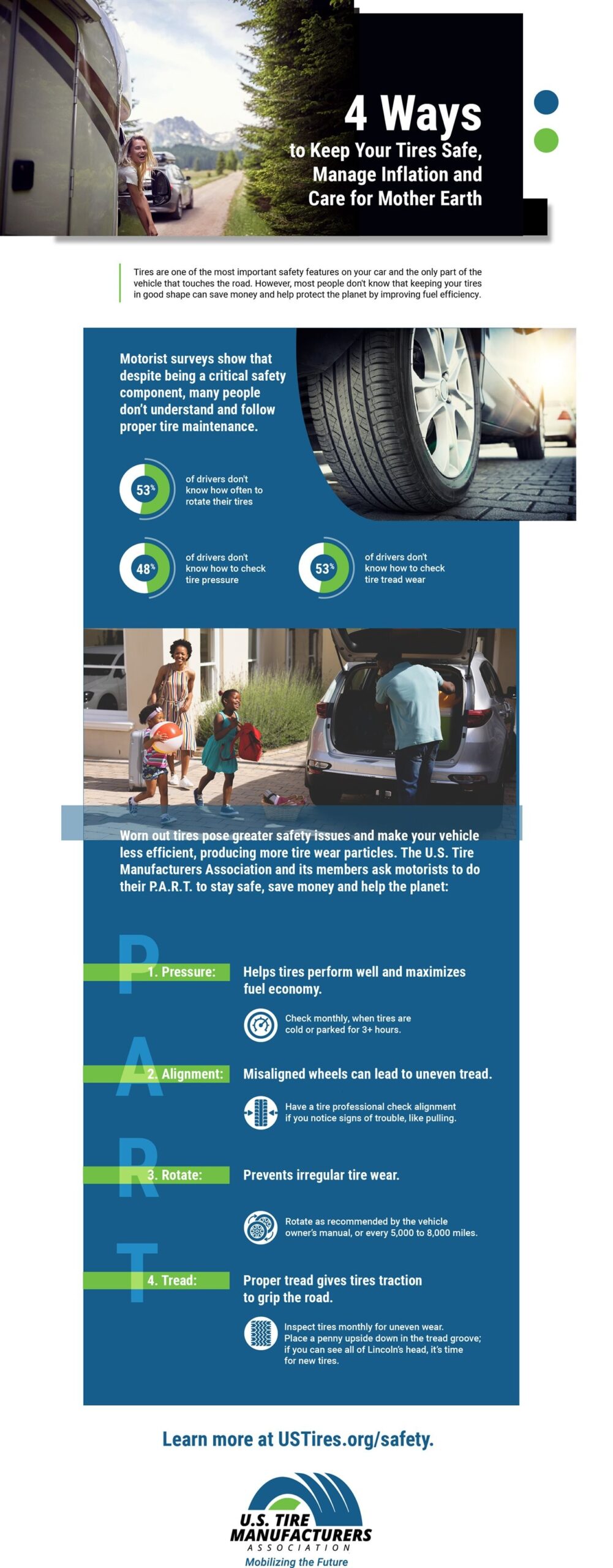(BPT) - When you think about the safety features on your car, seatbelts and airbags likely come to mind. While most people understand the lifesaving value of these devices, many are unaware of another important component of your car essential to safety: your tires.
Modern tires are carefully designed for safety, performance, efficiency and reliability. Each tire is an engineering marvel made of different layers and sections, including belts with steel cords for stability and strength; bead bundles made of wire strands that secure the tire to the wheel; and the outside tread, which grips the road for control of the vehicle.
"Tires are the most important safety devices you have on your car," said Anne Forristall Luke, president and CEO of the U.S. Tire Manufacturers Association (USTMA). "The contact patch of each tire is about the size of an adult palm print. This is all that connects you and your passengers to the road every time you drive, so it is critical we all take proper steps to maintain our tires on a regular basis."
Well maintained tires save on fuel
It's important to keep tires well maintained through their life cycle. In particular, proper tire inflation can help your tires last longer and improve fuel economy, which is especially important as consumers are feeling the impact of high gas prices at the pump. According to the National Highway Traffic Safety Administration (NHTSA), drivers can save as much as 11 cents per gallon on fuel by properly inflating their tires. Tire maintenance, such as rotation, balance and alignment, can help your tires last longer, which can extend the average life of a tire by 4,700 miles, also saving you money in the longer term.
Consumer safety and maintenance tips
"Research tells us that most people either don't know how often to check their tires, or simply forget. This is partly because many vehicles are equipped with features that let you know when tires need service. But it is still important to know how and when to check your tires for the best and safest performance," said Forristall Luke.
Spending a few minutes each month doing your part and checking your tires helps ensure they continue to work well and keep you safe. The acronym P.A.R.T. makes it easy to remember what to check, standing for Pressure, Alignment, Rotation and Tread.
1. Pressure
Proper inflation pressure gives tires the ability to support the vehicle so you can control it. Underinflated tires generate excessive heat buildup and stress, causing irregular wear and internal damage. Overinflated tires are more likely to be cut, punctured or damaged when hitting an obstacle, such as a pothole. Use a tire gauge to check inflation pressure monthly as well as before long trips. Inflation is measured in PSI, which stands for pounds per square inch, and you can find recommended pressure on a label on the driver's door or in your vehicle owner's manual.
2. Alignment
Hitting a curb or going over a pothole can cause alignment issues. Misaligned wheels can lead to uneven, rapid tread wear. Have your alignment checked by a tire professional at any indication of trouble, such as the feeling of the vehicle gently pulling to one side while driving. Alignment should also occur periodically along with a tire balance, as specified by your vehicle's owner's manual.
3. Rotation
Rotating your tires based on the recommendations in your vehicle's owner's manual can prevent irregular tire wear. If no rotation period is specified, opt to get a rotation every 5,000 to 8,000 miles. Once the tires have been rotated, make sure the inflation pressure is set to the vehicle manufacturer's specifications.
4. Tread
Tire tread equals traction. Lose too much tread and you could lose control on the road. Once your tread wears down to 2/32nds of an inch, it's time to visit your local tire shop. Take a few minutes each month to visually inspect your tires for uneven wear, high and low areas, unusually smooth areas and other signs of damage.
Here's a quick tread test: Place a penny upside down into a tread groove. If you can see all of Lincoln's head, it's time for new tires. Proper maintenance and periodic inspections by a tire service professional are essential for optimum performance and service life of tires.
Environmental benefits for the planet
Proper tire maintenance doesn't just help your tires perform well and keep you safe, it also benefits the planet. Proper maintenance reduces greenhouse gas emissions from vehicles and means less wear, which helps tires last longer. Finally, recycling done at tire dealers keeps used tires out of landfills and some are put to use in new, innovative ways in civil engineering projects such as roads and public spaces.
For more tire care tips and safety insight visit USTires.org/safety.


